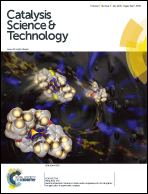Hyperbranched polyethylene-supported l-proline: a highly selective and recyclable organocatalyst for asymmetric aldol reactions†
Abstract
A novel hyperbranched polyethylene (HBPE)-supported L-proline has been developed via a bottom-up copolymerization strategy. Copolymerization of ethylene and a protected proline acrylate comonomer with cationic Pd-diimine catalysts was conducted, followed by de-protection of the proline groups. Well-defined HBPE copolymers having molecular weights (MWs) of 10.3–50.3 kDa and 3.2–15.6 L-proline molecules per HBPE polymer chain were synthesized. The effects of the L-proline amount and HBPE MW on the catalyst performance were studied. The HBPE catalysts were efficient in asymmetric aldol reactions of p-nitrobenzaldehyde (p-NBA) or benzaldehyde derivatives with cyclohexanone. High p-NBA conversions of up to 98% and excellent product selectivities with anti/syn = 98/2 and ee > 99% were achieved. Moreover, the HBPE catalysts could be easily recovered by adding water into the product. The recovered catalysts could be reused multiple times with only a slight decline in reactivity and selectivity.


 Please wait while we load your content...
Please wait while we load your content...